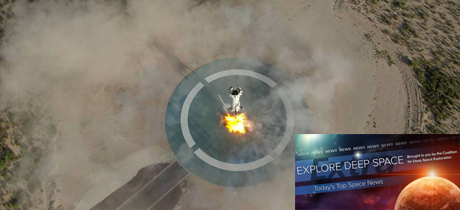In Today’s Deep Space Extra… Space exploration presents many challenges, requiring a range of experts to overcome. China appears increasingly committed to a leadership role in space.
Human Space Exploration
Design for a space habitat with artificial gravity that could be grown larger over time to fit more people
Universe Today (9/19): A Texas A&M University research initiative proposes a strategy to construct a human space habitat that could be expanded to house thousands. In order to achieve success, there are five major challenges to overcome, variances in gravity, cosmic and solar radiation, a means of growing food, a means of expanding the shelter and establishing and maintaining an asset with commercial value.
NASA to test precision automated landing system designed for the Moon and Mars on upcoming Blue Origin mission
Techcrunch.com (9/18): Blue Origin’s New Shephard suborbital rocket will soon provide a platform for testing a NASA precision landing system for use at the Moon and Mars. It’s called SPLICE, an acronym for “Safe and Precise Landing Integrated Capabilities Evolution,” a collection of technologies, including lasers, optical cameras and computers for landing guidance to spot and avoid ground hazards during a dynamic spacecraft touchdown.
Space Science
NASA finds evidence of “fresh ice” on Saturn’s moon Enceladus
Futurism (9/18): Imagery in the infrared from NASA’s Cassini orbiter at Saturn has revealed what appears to be fresh water ice in the northern hemisphere of the moon Enceladus, a potential biomarker. Cassini’s mission drew to a close in 2017 after 13 years. Earlier, astronomers detected evidence of icy eruptive activity on the moon, which appears to be ice and ocean covered. The latest findings were published in the journal Icarus.
Other News
Officials say NASA facing increased targeting by foreign and domestic hackers
The Hill (9/18): In testimony Friday before the U.S. House Science, Space and Technology Committee, NASA Inspector General, Paul Martin cautioned lawmakers that NASA is facing increased attempts by foreign hackers to invade IT systems to obtain sensitive information. “NASA has unfortunately been under attack from both domestic and foreign cyber criminals, and so it is just an ongoing, incredibly difficult issue to keep NASA’s defenses up,” said Martin. China is among those seeking to circumvent NASA’s security.
A rival for Elon Musk? Russia’s S7 Space seeks to create reusable rocket
Sputnik News.com (9/19): Roscosmos, Russia’s federal space agency, is looking at the possibility of a reusable rocket launch technology working with S7 AirSpace Corp., a Sea Launch floating spaceport. The effort involves a reusable first stage.
New study looks at space power competition through China’s lens
SpaceNews.com (9/20): “China’s Space Narrative,” a report led by the U.S. Air Force Air University’s China Aerospace Studies Institute and released September 14, suggests China seeks to become a global power and that part of the effort will be played out in space, where it wishes to be viewed as a capable and reliable partner. China views the U.S. commercial space sector, and especially SpaceX, as a role model for industry.
Chinese scientist envisions regular spacecraft flights by 2045
Xinhuanet of China (9/18): China is less than two decades from capabilities to launch a range of space missions, including one hour transits between global destinations among more than 1,000 missions annually, according to Bao Weimin, director of the Committee of Science and Technology at the China Aerospace Science and Technology Corp.
China launches new satellite to monitor ocean environment
Xinhuanet of China (9/21): Using a Long March 4B rocket, China on Monday launched an all-weather ocean surveillance satellite.
Major Space Related Activities for the Week
Major space related activities for the week of September 20-26, 2020
Coalition Member in the News – Boeing
Spacepolicyonline.com (9/20): This could be the week the U.S. House and Senate come to an agreement on and pass a budget continuing resolution (CR) for the start of the 2021 fiscal year, which begins October 1. The duration of an initial CR period is unclear, though December 11 is a possibility. The Senate Appropriations Committee has yet to mark up any of the 2021 spending measures. However, Wednesday afternoon NASA Administrator Jim Bridenstine is to appear before the Senate Appropriations Commerce Justice and Science subcommittee to discuss the Administration’s 2021 budget proposal, which includes a 12 percent increase to help meet a goal of returning astronauts to the surface of the Moon in 2024. The House version rejects any increase and would keep 2021 spending at the 2020 level.

